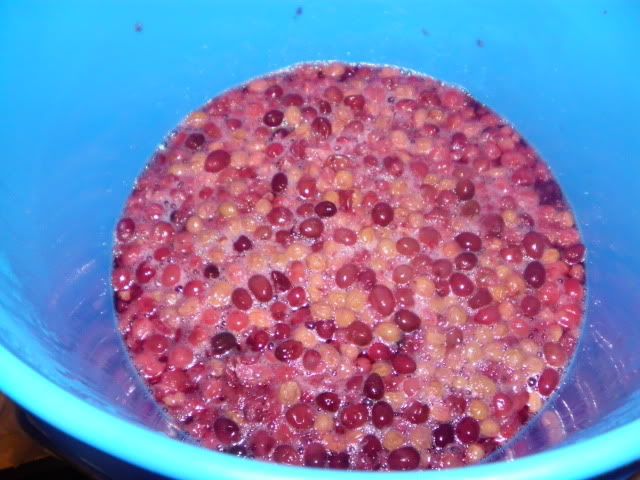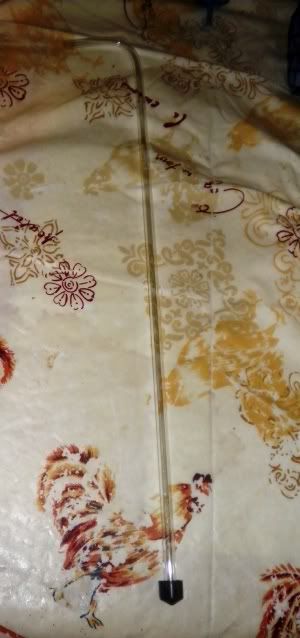Today was the 10th day that the wine had been fermenting so it was time to strain it. The worst part really is all the sterilizing. I was going to strain mine into a large pot and then put it in the jugs, just because that seemed the easiest way to do it. So I had to sterilize the large pot, the funnel, the cup I was going to pour with, the cloth I was going to strain through, the strainer, then the jugs, tops, airlocks and bungs. Plus Phil had to drill the holes in the tops of the jugs for me because my bungs didn't exactly fit the tops of the jugs. Anyway, once I got everything sterilized, things went along smoothly.
This is what it looked like to start with. I had been just picking up the bucket and swirling it around instead of opening so I hadn't actually seen it since about the second day. It was very obvious that things were going well from the minute I opened it. The whole house now smells like a winery and, if you ask me, it is a pretty nice smell.
So this had to be strained through a cloth in a strainer and then squeezed out. It is obviously not clear at this point. I could have let it set after the straining and then racked it afterwards. I did buy a racking cane...
but I have yet to buy the tubing to go with the racking cane. So this wine was just strained one more time through a small strainer into the jugs.
However before doing this I tasted it. It is amazing that it could taste so good already. I did add just a little more sugar before straining, putting in the jugs and putting the airlocks on. So now it sits for 30 days before I rack it (I should have my tubing by then).
I am incredibly pleased and can't wait to try another one. After all, we have to make more than 2 gallons! I see the wild muscadines in the woods are setting fruits this year. I imagine they would make a very nice wine.



What is a wild muscadine?
ReplyDeleteIt is a wild grape that grows here in the South.
Deletehttp://en.wikipedia.org/wiki/Muscadine
Some are green(called scuppernongs) and some are a more reddish color (not as dark as the picture in the link). The skin is tougher than domesticated grapes and some have one seed and others have several seeds like other grapes.
Thanks. I love the name "Scuppernongs"! It sounds very English, somehow.
DeleteIt does sound very English, lol, but they are actually named for a river in NC where they were found growing and the actual word Scuppernong originated from an Algonquian word.
DeleteOh my gosh that's so exciting!!! I have a couple of muscadine vines I am nurturing here in town and plan on putting in the ground at the farm. I'm so excited to see your progress, you make it seem so easy. I can't wait to hear how the final product comes out. Thanks for sharing.
ReplyDeleteGood luck with your mucadines. I planted one here but it never produced anything but I have found a couple of wild ones that produce some years
DeleteVery Cool! Can't wait to see the final product!
ReplyDelete